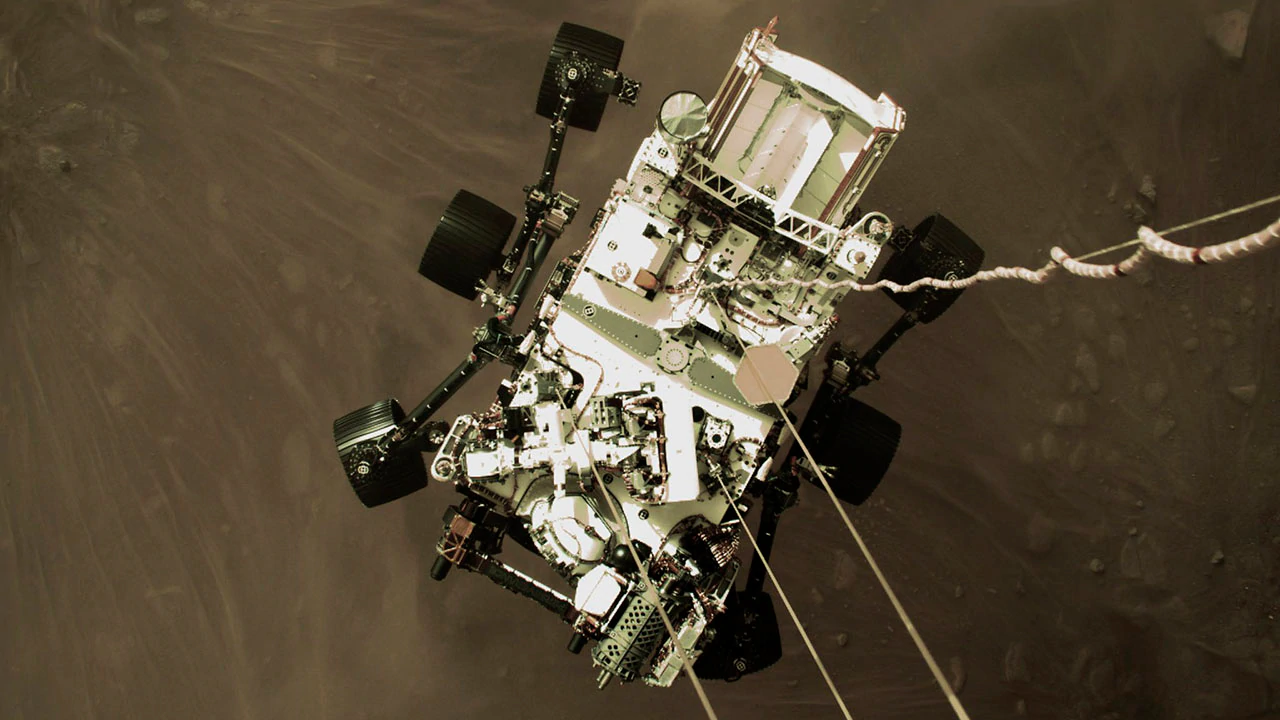NASA releases new images of Perseverance, surface of Mars

NASA’s Perseverance team has already begun its work from Mars’ surface and released incredible images on Friday taken from the rover.
In a news conference, experts said they could only hope the photographs from their mission might be able to contribute to already iconic images from years of space exploration.
HERE’S HOW NASA’S PERSEVERANCE ROVER WILL SEARCH FOR LIFE ON MARS
“And, I’m happy to say that I’m hopeful that we can contribute with this,” NASA Jet Propulsion Laboratory (JPL) Mars 2020 Chief Engineer Adam Steltzner stated.
In the first image revealed, Perseverance is shown approaching its landing site in Mars’ Jezero Crater and hanging just 6.5 feet over the ground. The image was taken from its “sky crane” jet pack descent stage before lowering the car-sized rover down to the surface on nylon tethers.
While NASA’s Curiosity rover — which landed on the red planet in August 2012 — had a sky crane, it did not have the same kind of imaging capability. Whereas, Perseverance has more than 20 high-resolution cameras and a microphone from which to take photos and the first-ever Mars video.
Mars 2020 hopes to have the video ready for public viewing by Feb. 22, 2021, when they will provide an update on their progress.
Officials report that the spacecraft is healthy and that they successfully fired their low-gain antenna to receive commands and were testing to see if their high-gain antenna is green and nominal, had three successful ultra-high frequency relay passes, and fired their hazard-avoidance camera covers as well as a couple of other things related to the rover’s robotic arm.
“It couldn’t have been better. We were just kind of like on cloud nine … this weird dreamlike state. We’re like: ‘We can’t actually believe that this is what we’re seeing,'” JPL’s assistant strategic mission manager Pauline Hwang said.
A second image taken from a hazard camera is the team’s first color image on the surface, showing the expansive landscape from a better vantage point and a wider scope.
The third includes part of one of Perseverance’s six wheels and a more detailed look at the rocky ground below. The rocks on the dusty ground below appear to have holes in them — and geologists seized on the images.
“And, one of the things that the scientists have first started to think about when we look at images like this is what the rocks are made of and what they look like,” explained JPL Deputy Project Scientist Katie Stack Morgan. “And so, we’re picking out different colors and tones and textures to try to figure out what these rocks might represent and what depositional process might have put these rocks on the surface of Mars.”
Morgan noted that there were a “number” of different geological processes that could make holes in a rock like the holes seen in the image and one of the first questions the team is asking is whether the rocks represent a volcanic or sedimentary origin both of which “would be equally exciting.”
The images are no doubt critical components to the purpose of Perseverance’s astrobiological experiment.
After the test flights of NASA’s first-ever Mars helicopter Ingenuity, “Percy” will hunt for biosignatures and signs of ancient microbial life.
Jezero Crater was carefully selected for the excavation and Mars Sample Return campaign, as the 28-mile-wide crater is believed to have once been flooded with water and home to an ancient river delta more than 3.5 billion years ago.
There is, of course, still work to be done testing tech and functions before the team can shift their focus, but the team is optimistic about the two-year investigation and Ingenuity.
“In the days to come, engineers will pore over the rover’s system data, updating its software and beginning to test its various instruments. In the following weeks, Perseverance will test its robotic arm and take its first, short drive,” NASA said in a Friday news release. “It will be at least one or two months until Perseverance will find a flat location to drop off Ingenuity, the mini-helicopter attached to the rover’s belly, and even longer before it finally hits the road, beginning its science mission and searching for its first sample of Martian rock and sediment.”
CLICK HERE FOR THE FOX NEWS APP
Nevertheless, Thursday’s landing was a monumental victory for the agency.
“Because of today’s exciting events, the first pristine samples from carefully documented locations on another planet are another step closer to being returned to Earth,” Thomas Zurbuchen, associate administrator for science at NASA, said on Thursday. “Perseverance is the first step in bringing back rock and regolith from Mars. We don’t know what these pristine samples from Mars will tell us. But what they could tell us is monumental – including that life might have once existed beyond Earth.”
Source link





